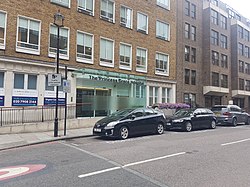Services
The hospital has introduced many new technologies [3] such as Modic Antibiotic Spinal Therapy, which is used to treat chronic low back pain caused by a bacterial infection in the spinal discs, [4] "Nanoknife", which destroys soft tissue tumours with an electric current, [5] the da Vinci robotic surgical system, which facilitates complex surgery, [6] "SmartPill", which is an ingestible capsule that detects changes in pressure, pH and temperature as it travels through the gastro-intestinal (GI) tract, [7] and vacuum assisted breast biopsy, which is when a hollow probe is guided into the abnormal breast tissue and a biopsy is pulled into the probe and cut off. [8]
In recent years, the hospital has grown from its main base on Nottingham Place, a few blocks west of Harley Street. The hospital has worked in partnership with the NHS and other stakeholders to develop the Institute of Sport Exercise and Health. This centre specialises in sports and exercise medicine and offers treatment to both elite sports professionals as well as those who only partake in sport at the weekend. [9]
This page is based on this
Wikipedia article Text is available under the
CC BY-SA 4.0 license; additional terms may apply.
Images, videos and audio are available under their respective licenses.

